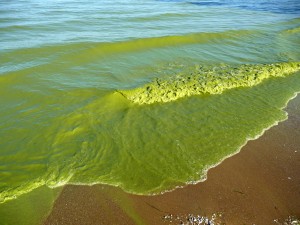Washington, DC–(ENEWSPF)–July 5, 2013) A bill recently introduced in the Ohio State Senate would grant state agencies new regulatory powers intended to stunt the spread of toxic blue green algae in Lake Erie. Senate Bill 150, introduced by Republican State Senator Cliff Hite, will empower the Ohio Department of Natural Resources (ODNR) and Ohio Department of Agriculture (ODA) to require reductions in the amount of fertilizer runoff that is produced by farms. Currently the state lacks authority to limit commercial fertilizer runoff. Swift action is needed as blue green algae blooms, which feed off phosphorus in fertilizer runoff, have increased dramatically in Lake Erie since the mid-1990’s. 
The proposed legislation would provide ODNR the authority to cite farmers who allow fertilizers to runoff their field. Under the proposed bill, the Chief of ODNR would issue orders to farmers to comply with technical standards, to be created by ODNR, that “achieve a level of management and conservation practices that will…abate the degradations of the waters of the state by soil amendments.” Under this legislation, farmers will have to undergo training and receive a certificate from ODA to apply fertilizers and manure. “Farmers would apply for a fertilizer certificate in the same way they obtain pesticide certificates,” Erica Hawkins, an ODA spokeswoman, told the Columbus Dispatch.
The bill, however has several limitations. Importantly, the bill would not require any new permits or certifications for animal feeding facilities. Confined Animal Feeding Operations (CAFOs) produce 133 million tons of manure per year (on a dry weight basis) representing 13-fold more solid waste than human sanitary waste production. Waste is often disposed of in wastewater lagoons, through which the waste can leech into ground water. Runoff from CAFOs also provides nutrients for algae bloom growth. Additionally, the bill does not make individual farmer’s fertilizer and manure-management plans public record. However, the bill will have time to be revised as the bill’s sponsor looks to gather comments from farmers and others over the summer. Ohio State Senator Bob Peterson favors amending the bill by moving ODNR’s power to regulate manure and fertilizer pollution to ODA.
The proposed bill is designed to stop the spread of a toxic blue-green algae bloom in Lake Erie, which scientists at the National Oceanic and Atmospheric Association (NOAA) predict to be significant this summer. Blue-green algae, or cyanobacteria, grow thick after feeding phosphorus in fertilizers, and manure that runoff into nearby streams that feed into Lake Erie. After Cyanobacteria consumes phosphorus it excrete a liver poison that is toxic to humans and aquatic life. The problem is also exacerbated by the increase in invasive species like zebra mussels. Zebra mussels feed on planktonic algae which remove competitors of the toxic algae bloom.
Not only are these blooms toxic, they are also a sink for dissolved oxygen, causing so-called dead zones. Scientists say that the water chemistry of dead zones may also cause the release of additional sediments that would otherwise be stored in cool, oxygenated waters. This could lead to the release of more toxins, such as mercury, in freshwater marine environments.
Studies have also found that as climate change creates hotter and more frequent extreme weather events, harmful algal blooms caused by fertilizer inputs will strike more often in water bodies like Lake Erie. In addition to the Great Lakes region, this summer the largest algal bloom ever recorded in China has grown twice the size from the previous record years’ bloom.
Agriculture is not the only source of excessive phosphorous pollution. Residential use of lawn care fertilizers represents a significant portion of the phosphorous load that runs into local water bodies in the U.S. For information on steps you can take to reduce the phosphorous contamination coming from your community, see Beyond Pesticides article, Maintaining a Delicate Balance.
Organic farming and land management uses natural, less soluble sources of nitrogen, phosphorous and magnesium, including cover crops, compost, manure and mineralized rock, that promote increases in soil organic matter and a healthy soil structure. Healthy soil structure allows water to infiltrate the ground slowly, rather than escaping across the surface and carrying soil particles, nutrients, and other inputs with it. Healthy soil structure also allows plants to establish vibrant root systems that resist erosion. For more information on the importance of an organic systems approach as a solution to , see Beyond Pesticides’ article, Increasing Biodiversity As If Life Depends on It.
For additional information on the Lake Erie algae bloom, visit our Threatened Waters: What the Science Shows page. For additional information water quality, please visit Beyond Pesticides’ Threatened Waters page.
Sources: Columbus Dispatch, http://www.beyondpesticides.org
Photo Source: Great Lakes Echo
All unattributed positions and opinions in this piece are those of Beyond Pesticides.








